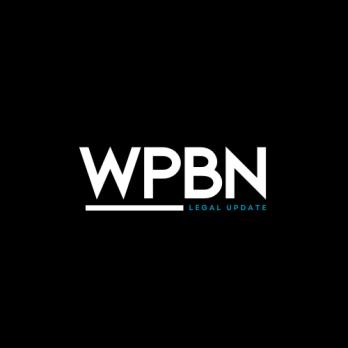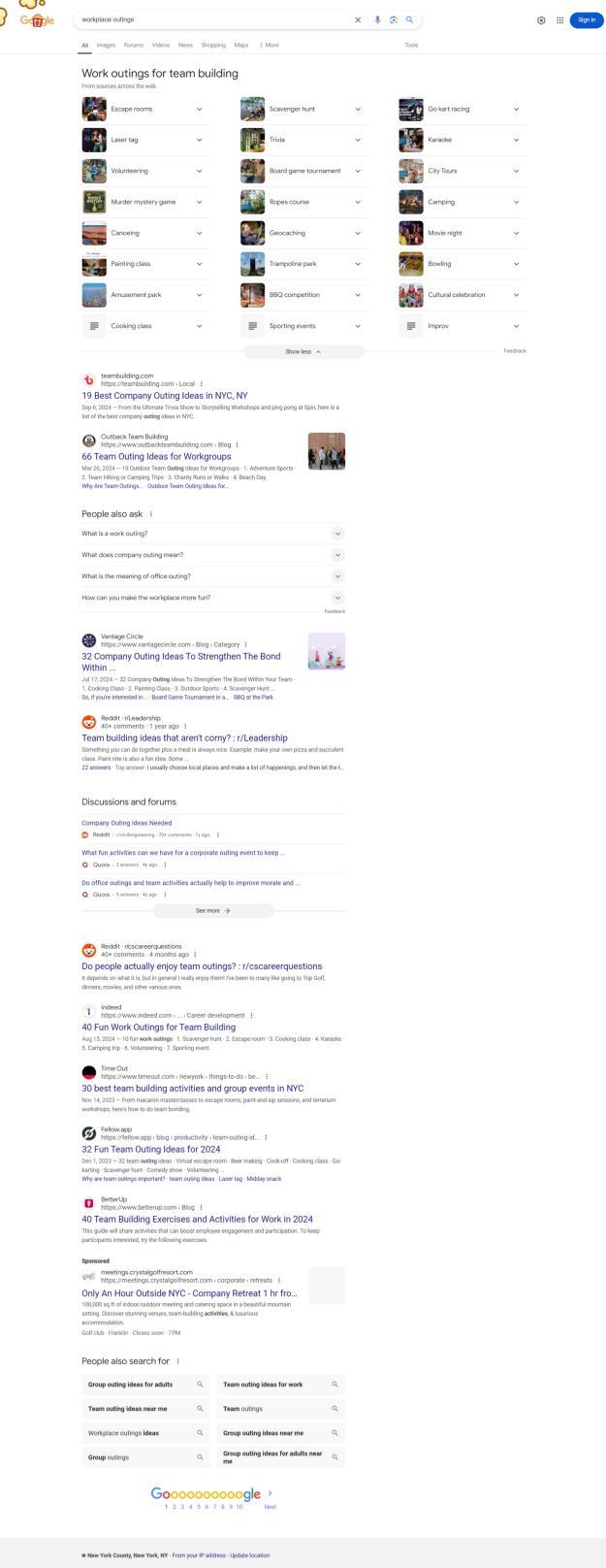1. Google Maps/Waze to suggest a destination route
2. Use Facial recognition to unlock your phone or online account
3. Watch a video, listen to music, or streaming recommendation on Spotify/YouTube/Disney+/Netflix
4. Submit a Google search suggestion
5. Use Grammarly to suggest writing corrections
6. Ask Alexa or Siri to tell you the weather or answer a question
7. Use Siri, Gmail, or Outlook to predict the next word you’re writing
8. Scroll upon Instagram/Snap/Facebook/LinkedIn recommended links
9. Use Google or Apple photos for recognition, or touch-up editing
10. Any translation apps or resources
Content Creation
Generate personalized marketing content, including product descriptions, social media posts, and email campaigns tailored to specific customer segments.
Countless Possibilities: Use Cases
Design and Creativity, Brainstorming Generally
Use AI to create designs, logos, and artwork for branding or product development, assisting graphic designers in generating new ideas or iterations.
Language Translation and Summarization
Language Translation and Automatically translate and summarize documents, emails, or web content into different languages, facilitating global communication and understanding.
Financial and Consumer Forecasting
Use productive analytics to analyze financial data and generate forecasts for better investment decisions or risk management.
Countless Possibilities: Use Cases
Personalized Product Design
Assist in designing customizable products by generating multiple iterations based on user preferences and requirements.
Chatbots and Customer Service
Develop AI-powered chatbots capable of engaging with customers, answering queries, and providing support 24/7, improving customer service experiences.
Search Engine Optimization
Enhances aspects such as content optimization, keyword research, and improve user experience. Machine learning algorithms can analyze vast amounts of data to identify patters and trends helping marketers to refine strategies. AI-driven tools can even provide personalized content recommendations.
Countless Possibilities: Use Cases
Automation of routine processes, such as email campaigns, social media scheduling, and performance tracking. This empowers marketers to focus on strategy and creativity while AI handles repetitive operational tasks. Back Office Automation
Video and Image Generation
Create synthetic images or videos for advertising, virtual try-ons for fashion, or editing and enhancing visual content.
Recommendation Systems
Utilize generative AI to build recommendation engines for personalized product recommendations or content suggestions based on user behavior and preferences.
Bias
• Learn from human-generated datasets.
• Absorb the biases present in the text, perpetuating stereotypes and discriminations.
Concerns
Bias
• In 2014, Amazon attempted to automate its hiring process by building algorithm to identify top talent.
Similar to how it rates products, Amazon’s hiring tool used artificial intelligence to give job candidates scores ranging from one to five stars.
Concerns
Bias
• Part of the algorithm used resumes submitted to the company over a 10-year period.
Since most came from men, the algorithm began to favor men.
For example, it penalized resumes that included the word “women’s,” as in “women’s chess club captain.”
Unforeseen Consequences
Potential
Failing to adhere to regulations and standards, especially in highly regulated industries such as healthcare or finance.
Concerns
Unforeseen Consequences
Overreliance
Concerns
Policy Considerations
• Prepare a workplace policy governing the use of Generative AI for employees.
Steps to Create a Generative AI Policy
• Establish a team of relevant personnel.
The team should include collaboration from legal, IT, and business teams.
• Team must align business objectives, while addressing ethical, legal, and operational considerations.
Take Inventory of Use Cases: Aggregate and assess what’s working, what’s not.
Steps to Create a Generative AI Policy
Set Clear Objectives
Define the goals and objectives for using generative AI within
Steps to Create a Generative AI Policy
Set Clear Objectives
Include a clear list of authorized and intended uses.
Examples: Draft emails, letters, memorandums or presentations
• Conducting research
• Creating marketing materials
Steps to Create a Generative AI Policy
Risk Management
Implement risk management protocols to mitigate potential risks associated with AI, including bias detection and mitigation strategies.
• Vet any proposed AI, test for performance in a real-world context. Think “mock trial” and pilot programs. Assess your organization’s risk comfort level. None of this is without risk.
Risk Management Company should retain right to monitor
Steps to Create a Generative AI Policy
Risk Management
• Require employees review all AI inputs and outputs before use. This should include:
• Ensuring they don’t contain offensive or discriminatory material
• Do not contain personal or confidential information
• Information is accurate
• A general understanding of the provided information’s provenance, quality, appropriateness, and relevancy. Using a representative data set?
Steps to Create a Generative AI Policy
Monitoring and Evaluation
Establish mechanisms for continuous monitoring, evaluation, and auditing of AI systems to ensure they operate as intended and adhere to established policies.
Steps to Create a Generative AI Policy
Accountability and Responsibility
Define roles and responsibilities for individuals involved in implementing and overseeing AI systems, ensuring clear accountability.
Steps to Create a Generative AI Policy
Adaptability and Updates
• Recognize the evolving nature of AI technologies and the need to update policies regularly to address new challenges and opportunities.
Steps to Create a Generative AI Policy
Training and Awareness
Provide training and awareness programs to employees, ensuring they understand AI's capabilities, limitations, and ethical considerations.
Steps to Create a Generative AI Policy
• Generative AI was used to create this presentation.
All material was reviewed, and corrections were made where appropriate.
Questions?
Rahool Patel David L. Disler
Whose Data Is It Anyway?
▪ Facts
▪ Numbers
▪ Dates/Times
▪ “Personal Data” is any information linked or linkable to an identifiable person
▪ The use and governance of Personal Data
Concept based upon autonomy and having control
What is Data Privacy?
▪ Controllers that conduct business in NJ or produce products or service targeted to NJ residents
▪ For profit and non-profit entities alike
▪ 100,000 consumers or 25,000 consumer (if revenue or discount from sale of personal data)
▪ NJDPA does not include any form of revenue threshold for applicability so even businesses with relatively low revenues may be in scope
NJDPA: Scope
NJDPA: Exemptions
▪ NJ government entities (or of any political subdivision of New Jersey)
▪ Financial institutions and affiliates or data subject to the GrammLeach-Bliley Act (GLBA) [entity level & subject level exemption]
▪ Protected health information (PHI) collected by a HIPAA covered entity [subject level exemption]
▪ Insurance institutions [entity level]
▪ Data subject to the Fair Credit Reporting Act (FCRA) [subject level exemption]
▪ BUT, does not include a common exemption for educational data or data processed by non-profits or higher education institutions
NJDPA: Consumer Rights
▪ The NJDPA gives consumers the following rights :
▪ The right to confirm whether a controller is processing personal data and to access that data;
▪ The right to correct inaccuracies in the personal data;
▪ The right to delete personal data;
▪ The right to obtain a portable copy of personal data; and
▪ The right to opt out of the processing of data for purposes of targeted advertising, the sale of personal data, or, in certain circumstances, profiling
NJDPA: Organization Obligations
▪ Transparency / Purpose Limitation
▪ Specify purpose of processing (e.g.Privacy Notice requirement)
▪ Minimization (adequate, relevant, reasonably necessary)
▪ Administrative + Technical + Physical data security practices
▪ Need consumer Consent to process Sensitive Data
▪ Cannot process personal data of a known child (u13) unless COPPA
▪ Cannot discriminate (for exercising rights or for effect)
▪ Respond to a verified Data Subject Requests within 45 days
Targeted Advertising
▪ Targeted Advertising = displaying advertisements where the advertisement is selected based on personal data obtained or inferred from that consumer’s activities over time and across nonaffiliated Internet web sites or online applications to predict such consumer’s preferences or interests
▪ Enforcement Example (from California):Sephora
▪ Alleged to violate the CCPA by:
▪ deceptively allowing third parties to track consumer information online in exchange for targeted advertisements
▪ Failing to process visitor request to opt-out of sale via a Global Privacy Control setting
▪ Failed to cure after notice
Spectrum of Sensitive Data Categories
Sensitive Data in the NJDPA:
Issues
to Consider When Thinking Global: The Growing Network of International Privacy Laws
Federal Trade Commission (FTC)
FTC protects consumers from unfair or deceptive trade practices
FTC promulgates regulations, enforces privacy laws, and takes action against companies to protect consumers when such companies:
▪ Fail to implement and maintain reasonable data security measures
▪ Fail to comply with industry standards
▪ Do not comply with a privacy policy/statement/notice
▪ Use personal information in a manner not disclosed in a privacy statement
▪ Fail to properly secure personal data
▪ Collect, use/process, share, or sell personal data in violation of data privacy rights
FTC and HHS/OCR recent statements on privacy and data governance…
“Companies have a responsibility to secure data they maintain and to delete data they no longer need.” –February2024,Blackbaudsettlement
“Protecting consumers’ sensitive health data is a high priority for the FTC.” –April2024,HBNRchangesannounced
“You should fully understand where all electronic protected health information exists across your organization - from software, to connected devices, legacy systems, and elsewhere across your network.” – February2022,OCRDirectorLisaPinto
Protecting Your Business: Know Your Data
▪ Data Mapping and Inventorying
▪ Undertake a data mapping exercise to understand the types of data the organization processes and maintains, the purposes for which the data is used, and whether all data is needed
▪ Data is likely being collected on your Website
▪ Does your organization utilize cookies or other trackers on its website(s)?
▪ Does your business allow others to place cookies or other trackers there?
Protecting Your Business: Know Your Processes
▪ Do you know what Personal Data you have?
▪ Do you know how Personal Data is being used or shared?
▪ What are your Service Providers / Vendors / Affiliates doing with Personal Data?
▪ If your organization sells personal data to third parties or processes personal data for targeted advertising or profiling purposes, such activities must be disclosed in the privacy notice and consumers must be afforded opportunity to opt-out
▪ Review business relationships with third-party data processors to understand the role of each party and potential requirements
Considerations for Business
▪ Proactive Prevention versusReactive Remediation
▪ Leverage existing compliance infrastructure to adopt a proactive approach to data governance
▪ Is Personal Data being processed for legitimate and lawful business purposes in accordance with policies, SOPs and applicable law?
▪ Consider what tools are already in place
▪ Policies related to how data is collected, used, and handled?
▪ Is the company already acting transparently?
▪ Notices and consents collected and maintained (consent management platforms)
▪ Vendor Contract and Practices Management
Brian Giardina
Alfred R. Brunetti
State Taxation of Remote Workers
▪ Impact of Remote Work on State Taxation
o Increased remote work post-pandemic: Complex state tax implications.
o Residency and Tax Obligations
▪ NJ residents taxed on worldwide income (N.J.S.A.54A:2-1).
▪ Remote workers’ income from other states: Potential double taxation.
o Nexus Considerations
NJ's economic nexus: Tax authority without physical presence (N.J.S.A. 54:10A-2).
Multi-State Compliance Strategies
▪ Navigating Multi-State Tax Obligations
o Consistent Policies for Remote Workers
▪ Clear guidelines on work locations to manage tax liabilities.
▪ Tracking where employees work.
o Payroll and Withholding Tax Considerations NJ rules on withholding: Employers must
o Managing Audits and State Tax Disputes
▪ Prepare for audits with thorough records.
▪ Consider voluntary disclosure agreements (VDAs) for past liabilities. Some states will report their audit findings to other states.
Questions?
Deirdre R. Wheatley-Liss
Daniel S. Makoski
Janelle Edwards-Stewart, Esq.
Lisa N. Brown, Esq.
The Real Story
DePierov.PennsylvaniaStateUniversity(2024)
▪
▪
General Program Guidance
Dima Ghawi
Lisa N. Brown Janelle Edwards-Stewart
Patricia C. Morgan
Richard H. Bauch
Kerri A. Wright Thomas J. Reilly
Beau W. Huch
US Supreme Court declares lateral transfers that cause “some harm” to be unlawful under federal law
Muldrowv.CityofSt.Louis
▪ Plain clothes police officer was transferred to a ‘less prestigious’ position
▪ Lateral position
▪ Same rank and same pay / different duties and different hours
▪ ‘Some harm’ is enough to trigger liability
▪ Raises many questions
Texas District Court Halts FTC Ban on Non-Compete
What Happened?
▪ Federal Trade Commission ban on non-competes was set to begin on September 4, 2024
▪ Texas District Court issues injunction with nationwide effect
▪ Appeal to the 5th Circuit likely
What now?
▪ Cautiously continue lawful practices with respect to non-compete agreements, subject to state restrictions
You Don’t Discriminate. But Does Your A.I.?
▪ Can A.I. job screening tools unwittingly discriminate against certain job applicants?
▪ What are the employer’s responsibilities to protect against this potential discrimination?
▪ Intentional vs. disparateimpact discrimination.
Mobleyv Workday,Inc (N D Cal 2024)
▪
▪
Doesn’t
Have You Received an Accommodation Request Without Realizing it?
▪ No “magic words” necessary for accommodation request under the ADA.
▪ Context is critical.
▪ Training managers to spot requests will be key.
▪ Reach out to counsel when there are close calls.
Yannickv KrogerCo ofMich (6th Cir 2024)
Patricia C. Morgan
Richard H. Bauch
Kerri A. Wright
Thomas J. Reilly
Beau W. Huch
•
Shouldyou
Liability for Accidents and Injuries
“Our company made the ‘Company BBQ’ mandatory, and they held it at a park, we had one guy tear his ACL while playing flag football and another got bit by a stray dog both claimed workers' comp” YouTubeComment
▪ Discrimination
▪ Harassment
▪ Company Policy Where Did It All Go Wrong?
Dealing with Inappropriate Behavior
▪ Dazzling the Boss to Curry Favor and Promotion
▪ Making a Dangerous Activity Seem Obligatory
▪ ‘Mandatory’ Fun
▪ Discrimination by Gender Assumptions
▪ Creating Tension and Hostility between Team Members
▪ Risks to the Health & Safety of Employees
▪ Leaders not Participating in Team Activities
A DAY IN THE LIFE: Starring Workplace Injuries and Workers’ Compensation Claims
RatedR - Required watching for workers’ comp. compliance
Directed by Sal Anderton Produced by Melanie Lipomanis
What is Worker’s Compensation?
The Worker’s Compensation program was created as a social safety net through legislation to provide medical treatment, wage replacement, and permanent disability compensation to employees who suffer jobrelated injuries or illnesses, as well as death benefits to dependents of workers who have died as a result of their employment.
Employers are required by law to carry worker’s compensation insurance for employees.
▪ Any work-related injury or illness that occurred in the course of the employee performing his/her duties or while on the employer’s premises for the benefit of the employer
▪ Any injury or illness caused by the negligence of the employer or a coworker (see exceptions to the exclusive remedy)
▪ Occupational Illness
▪ Death
What is Covered?
▪ Non-work related medical conditions or diseases that are not caused by nor exacerbated from working conditions.
Examples:
▪ Kidney failure ▪ Heart disease /attack (sometimes)
▪ Diabetes
Appendicitis ▪ Cancer (sometimes) ▪ Mental Illness (sometimes)
▪ Specialnoteforlawenforcement, publicsafety,andmedicalemergency workers
Special Episodes in Workers’ Comp. Cases
Whether workers’ compensation is applicable to an employee’s injury often depends on special attending factors of
• Where …
• When …
• How … and
• Why … the injury occurred
Commuting and Traveling
However, if the job duties require the employee to travel, any injury that occurs while traveling in the course of employment is workrelated and subject to workers’ compensation laws.
Mental and Psychological Conditions
New Jersey's workers' compensation law covers mental and psychological conditions that arise from work-related events, including depression, anxiety, and post-traumatic stress disorder (PTSD). To qualify for benefits, the condition must be severe enough to interfere with the employee's ability to perform their job.
There must be sufficient medical evidence that the condition was objectively work-related to be eligible for coverage.
Horseplay and Skylarking
A certain amount of horseplay is to be expected in any workplace and is generally always covered by WC
Unless the employer can show that the horseplay constituted a major deviation from the employee’s work duties
Workplace Fighting / Assaults
Workplace injuries caused by physical violence are covered under Workers’ compensation laws if the dispute giving rise to the physical altercation is work related.
Employer-Sponsored Events
If an employer requires employees to attend an event and an injury occurs, the injury is compensable.
However, there is a gray area where attendance to the event is not mandatory.
Off-Duty Employees on Employer Premises
Exception to the Employer Premises Rule
An employee who is on the premises, not for the benefit of the employer but for their own benefit, and is free of all duties, is not covered by WC for any injury they suffer.
Again, the employer's premises includes any property that the employer owns or controls.
Moonlighting Employees
Generally, workers’ compensation benefits are tied to the job the employee was working when he or she was injured.
This is true even if the injuries prevent the employee from working both jobs.
Employees Under the Influence
Employers can challenge eligibility for worker’s compensation benefits if they can show 2 things:
The injured employee was intoxicated at the time of the injury (with blood or urine analysis)
And the intoxication was the sole cause of the injury
Pre-existing Conditions
The Second Injury Fund makes benefit payments to injured workers who are totally and permanently disabled as a result of work-related injuries combined with pre-existing disabilities.
The Fund was established to encourage employers to hire disabled workers. The employer only pays for the work-related aspect of the total disability award.
Workers from a Temp Agency
The remedy for a temporary worker assigned through an agency is usually covered by workers’ compensation with the placement agency.
The agency normally contracts with its client to cover workers’ compensation claims of the employees it places with the client.
Medical Care – Who Chooses?
The employer and their insurer have the right to select the doctor(s) an employee will see after a workplace injury
However, if the employee objects with the care given, they can obtain a second opinion and petition to change treatment plans and care providers
Employers may inquire with the treating physician if light duty is appropriate for transitioning the employee back to work early.
If the employee refuses light duty, they can lose their WC temporary disability benefits.
employers should require medical certification that the employee is medically fit to perform duties that theemployerhas identified in a written job description.
Employers may require a second medical opinion, with a provider of its choosing, if it questions the accuracy of a prior opinion regarding the employee’s condition.
Once a doctor has certified an employee has reached maximum medical improvement (MMI), if they still cannot perform the essential duties of job they may lawfully be discharged.
Melanie D. Lipomanis
Sal M. Anderton


































































































































































































































































